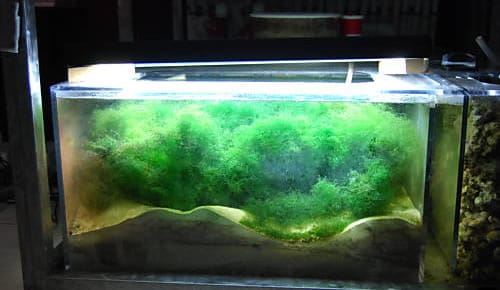Are you looking for a more natural approach to a saltwater aquarium? Perhaps a Refugium is for you! A Refugium is a safe place where microorganisms called Copepods can grow and reproduce. These pods help break down detritus and feed on uneaten food. Popular macroalgae like Chaetomorpha and Caulerpa can be grown with an ordinary light to reduce nitrates. The addition of rubble live rock and a four to eight inch deep sand bed can also combat high nitrates.
Pre-Built Refugiums can hang on the back of your aquarium or can be added as a compartment in the sump. You can also convert your existing Sump into a Refugium by adding a few compartments with baffles. A Refugium can also be run in conjunction with a Protein Skimmer or Wet/Dry Filter.
How to Build a Refugium
1. Fill the desired area with at least four inches of Live Sand.
2. Build several mounds of rubble Live Rock, to help reduce nitrates and provide a breeding ground for Copepods and amphipods.
3. If the aquarium is at least one month old, add the desired macroalgae and weigh it down with a couple pieces of live rock. If the aquarium is under one month old, wait to add the macroalgae as it tends to waste away without a source of nitrate and phosphate.
4. Turn on the Refugium light. Some hobbyists run the light 24 hours a day to prevent macroalgaes like Caulerpa from going asexual and reproducing. Other hobbyists run a reverse photoperiod, the light is on opposite hours of the display tank, to combat drops in pH.
5. Adjust the flow in the Refugium to 100 to 300 gallons per hour. This will prevent the macroalgae and pods from being flushed out of the Refugium.
6. When the macroalgae begins to fill the Refugium, you may weed it back to allow for new growth.

Chaetomorpha and Other Macroalgae
Remember that some macroalgaes like Caulerpa will attach to Live Rock and are extremely difficult to remove. It is important not to let Caulerpa attach to live rock in your display tank as it can quickly take over. Cheatomorpha is a better choice as it will not attach to rock and won’t go asexual.
Over time, you will begin to see copepods flourishing in the Refugium and display, maybe enough to keep a Mandarin Goby. Copepods will drift out of the refugium and make their way to the display aquarium through a drain or return pump. Initially many aquarists were worried their pods would be chopped up by the return pump, but pods have proven to be durable. For the few that do get chopped up, there are hundreds that make it through successfully.
A Refugium is a simple and natural approach to aquarium filtration and live feeding. It can be combined with a wet/dry filter or protein skimmer to further enhance water quality. Many aquarists appreciate their Refugium because it contains many diverse species of life. It can also be used to house non-reef safe or small creatures that would ordinary be lost in the display aquarium.
